Introduction to Banksy
Banksy, an anonymous street artist originating from Bristol, England, emerged in the 1990s and has since become a pivotal figure in contemporary art. His distinctive stenciled artworks, often infused with political and social commentary, critique themes such as consumerism, war, and societal inequalities. Despite his concealed identity, Banksy’s influence permeates global art scenes, challenging traditional art paradigms and redefining public space utilization.
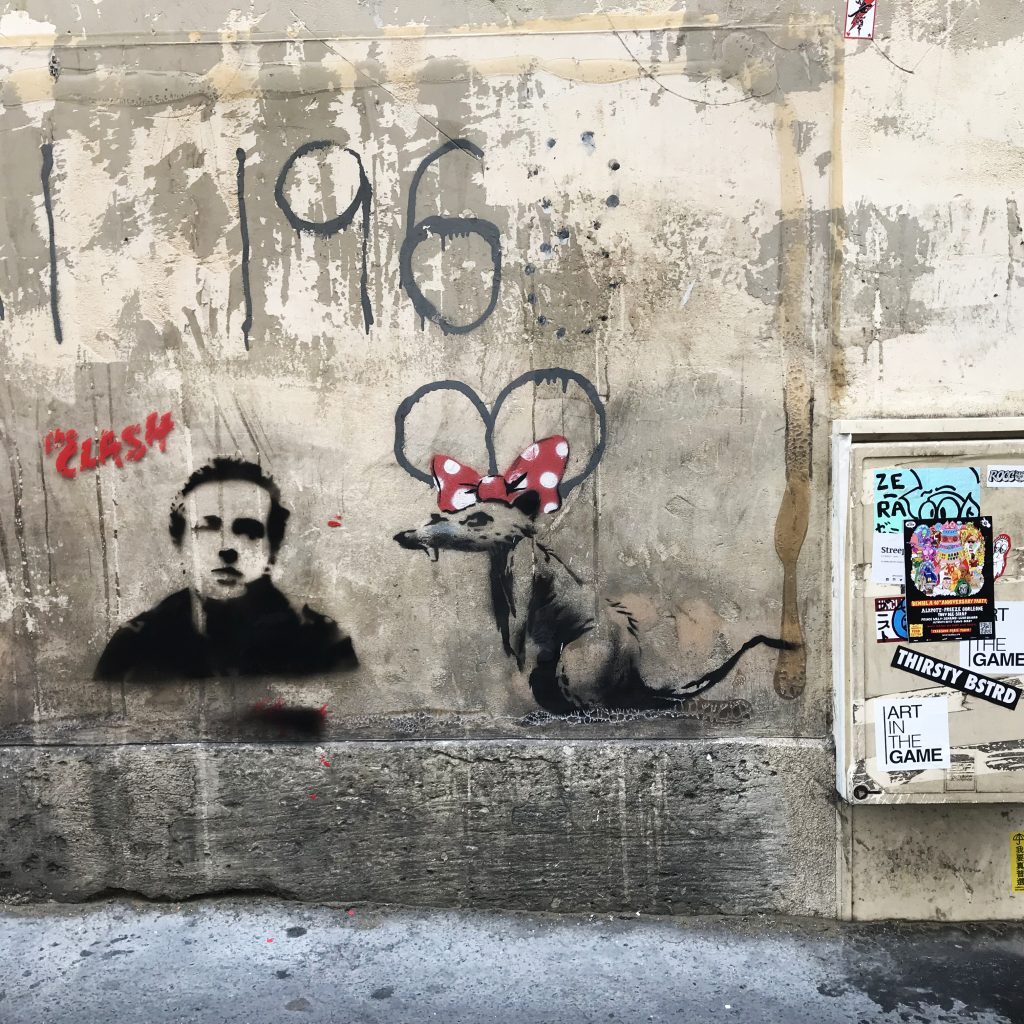
5Banksy’s Rat with a Minnie Mouse Bow, blending playful imagery with urban grit on Rue de Clignancourt. Photo Fredrik Hagblom
Banksy’s Foray into Paris
In June 2018, coinciding with the 50th anniversary of the May 1968 uprisings and World Refugee Day, Banksy executed a series of murals across Paris. These artworks, estimated to number between eight and ten, addressed pressing issues including the refugee crisis, the resurgence of far-right ideologies, and the commodification of art. His interventions in Paris not only paid homage to the city’s rich artistic heritage but also served as a critique of contemporary socio-political dynamics.
Detailed Examination of Notable Works and Their Locations
1. The Girl Covering a Swastika (Porte de la Chapelle)
Situated near the Porte de la Chapelle metro station, this mural portrays a young girl attempting to conceal a swastika with pink wallpaper. This imagery critiques the superficial attempts to mask underlying prejudices without addressing their root causes.
2. The Businessman with a Saw (Sorbonne University)
Located near the Sorbonne University, this piece depicts a suited man offering a bone to a dog while concealing a saw behind his back. The dog, missing a leg, suggests that the bone is the dog’s own limb, symbolizing exploitative practices where benefactors are responsible for the harm they ostensibly remedy.
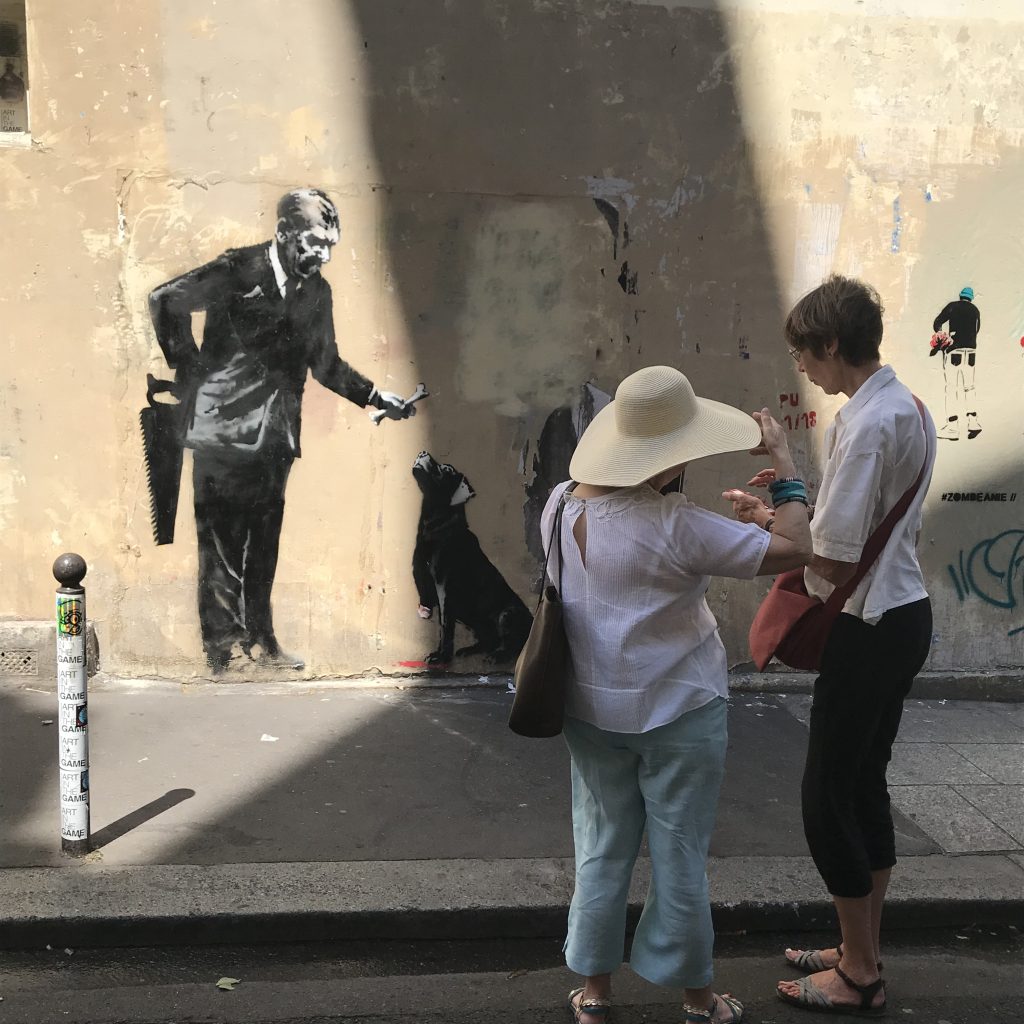
Businessman with a Saw, one of Banksy’s Paris murals, critiques exploitative practices through striking symbolism near the Sorbonne. Photo: Fredrik Hagblom
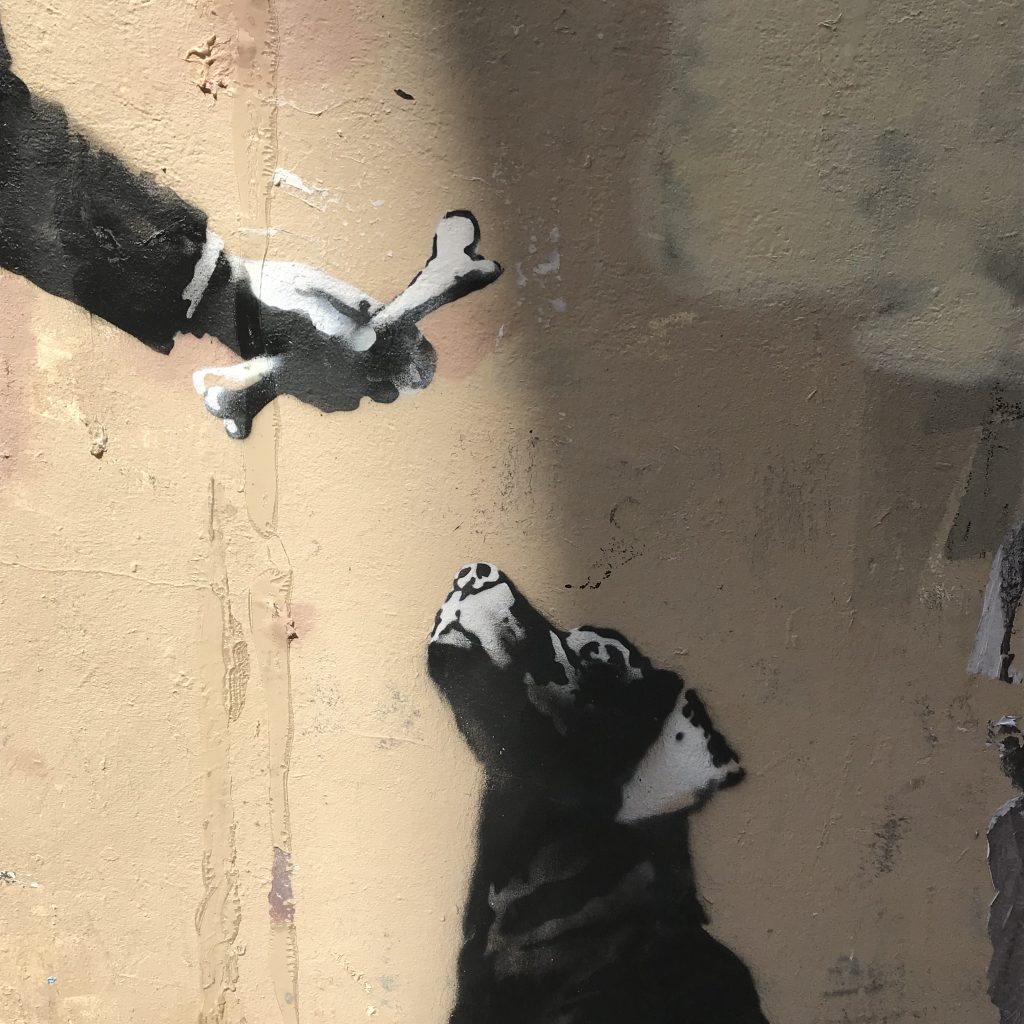
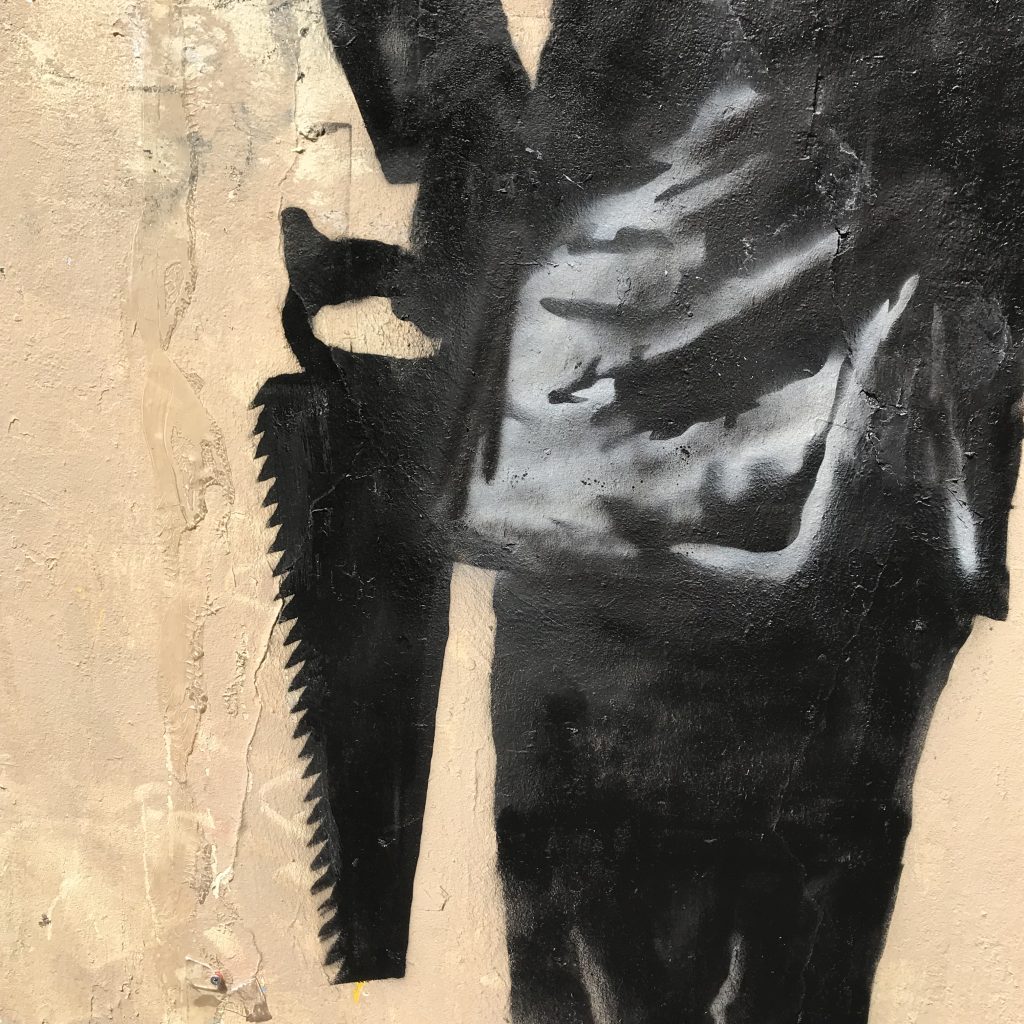
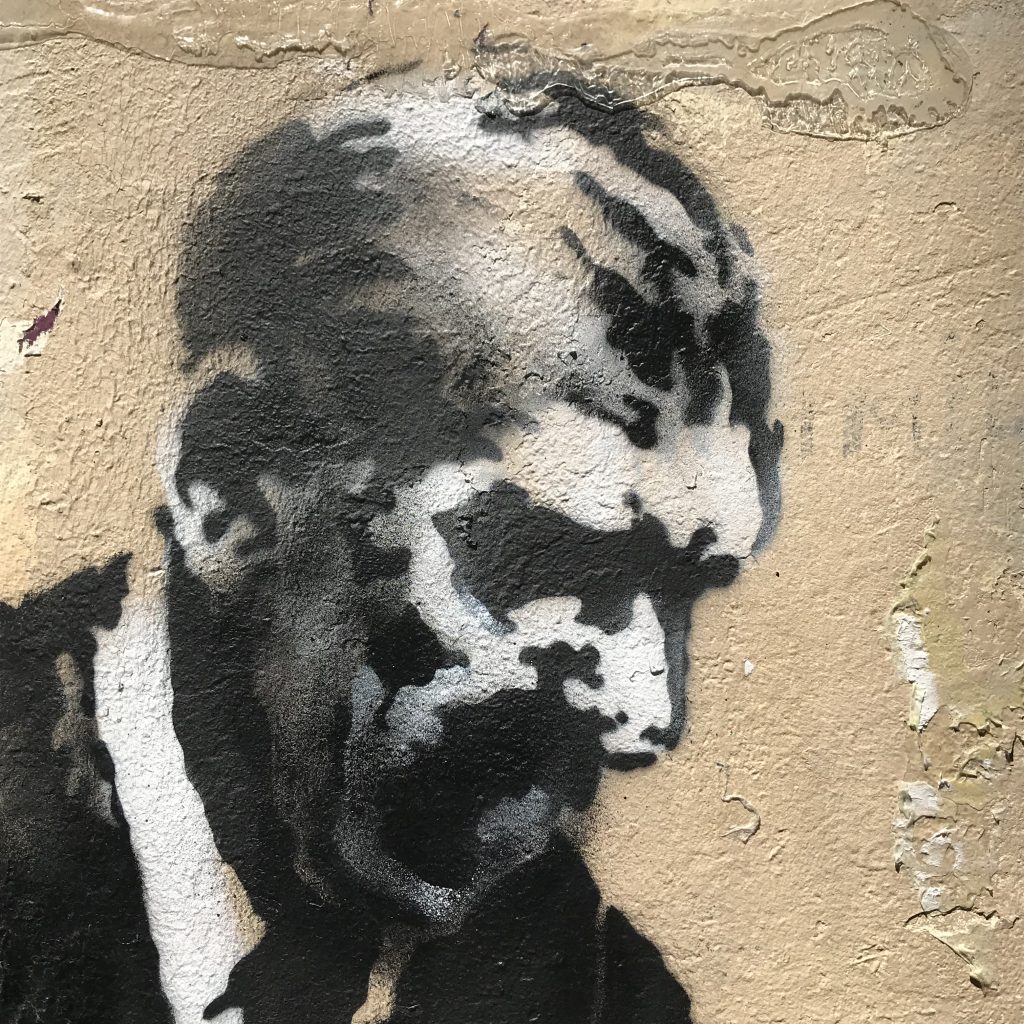
3. The Rat with a Champagne Bottle (Rue de Montreuil)
This mural features a rat brandishing a champagne bottle, with the cork mid-explosion. The rat, a recurring symbol in Banksy’s oeuvre representing the marginalized, appears to celebrate, possibly alluding to the resilience and enduring spirit of the underclass.
4. The Rat with a Mask (Near the Centre Pompidou)
Adjacent to the Centre Pompidou, this artwork shows a rat with a masked face, wielding a utility knife. This piece may reference the 1968 Paris student protests, symbolizing rebellion and the fight against oppressive systems.
5. The Mourning Figure (Bataclan Concert Hall)
On an emergency exit door of the Bataclan, Banksy painted a veiled, mournful female figure, interpreted as a tribute to the victims of the 2015 terrorist attack at the venue. This poignant piece underscores themes of loss and remembrance.
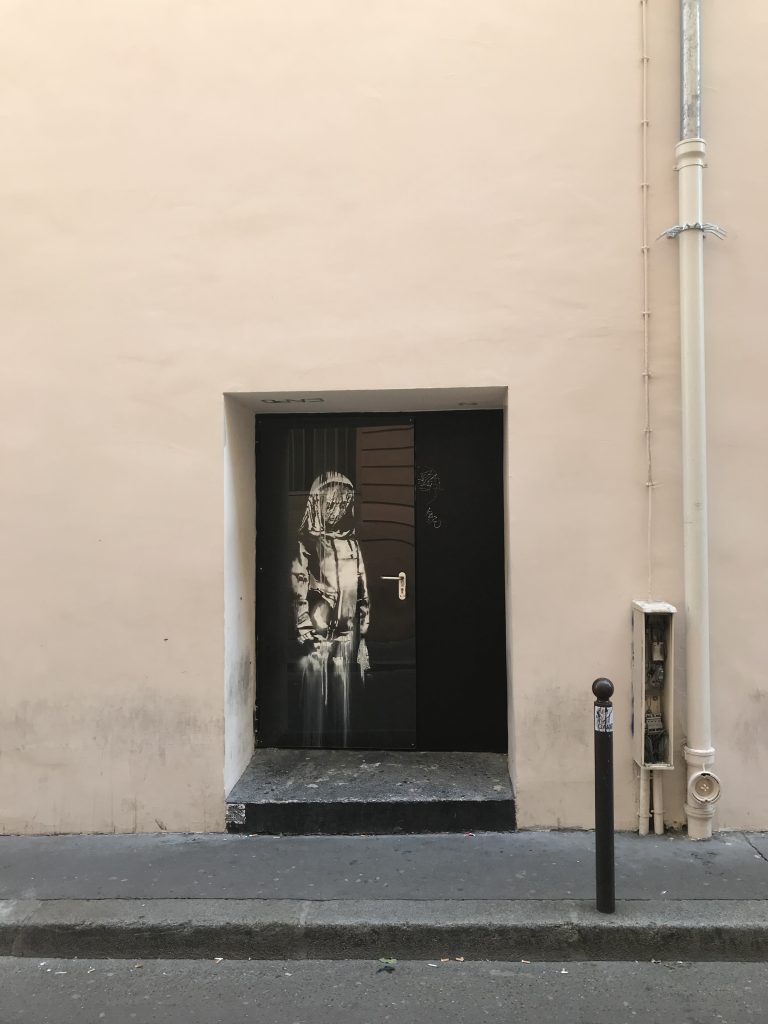
Banksy’s The Mourning Figure, a tribute to resilience and remembrance, painted near the Bataclan concert hall. Photo: Fredrik Hagblom
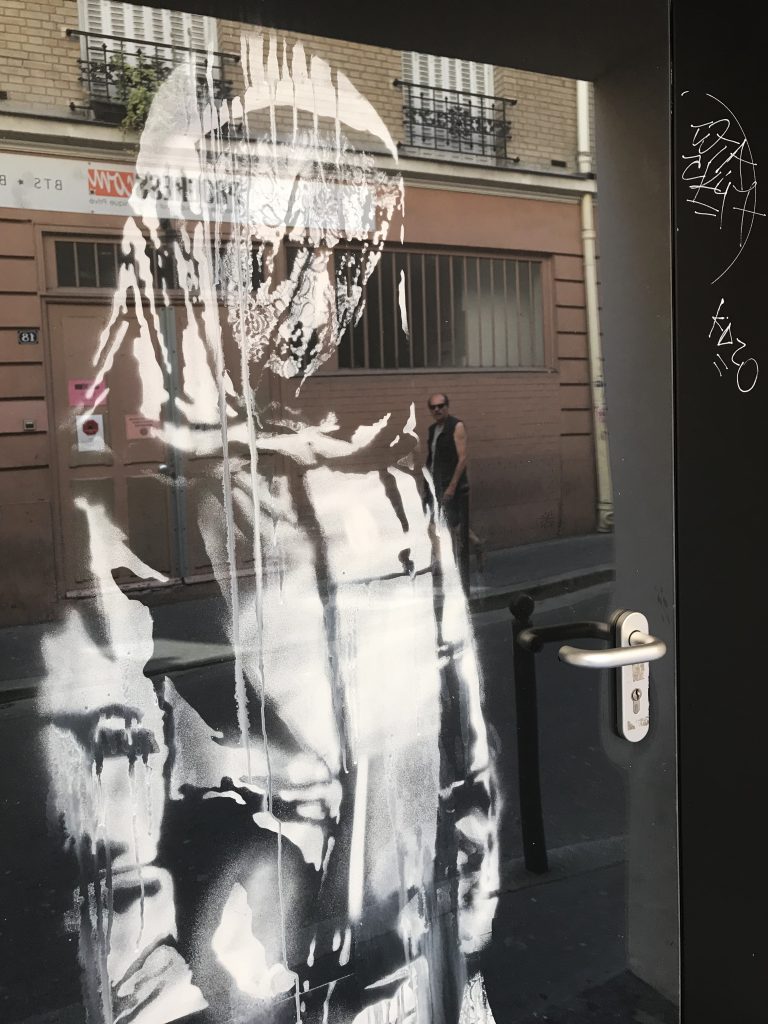
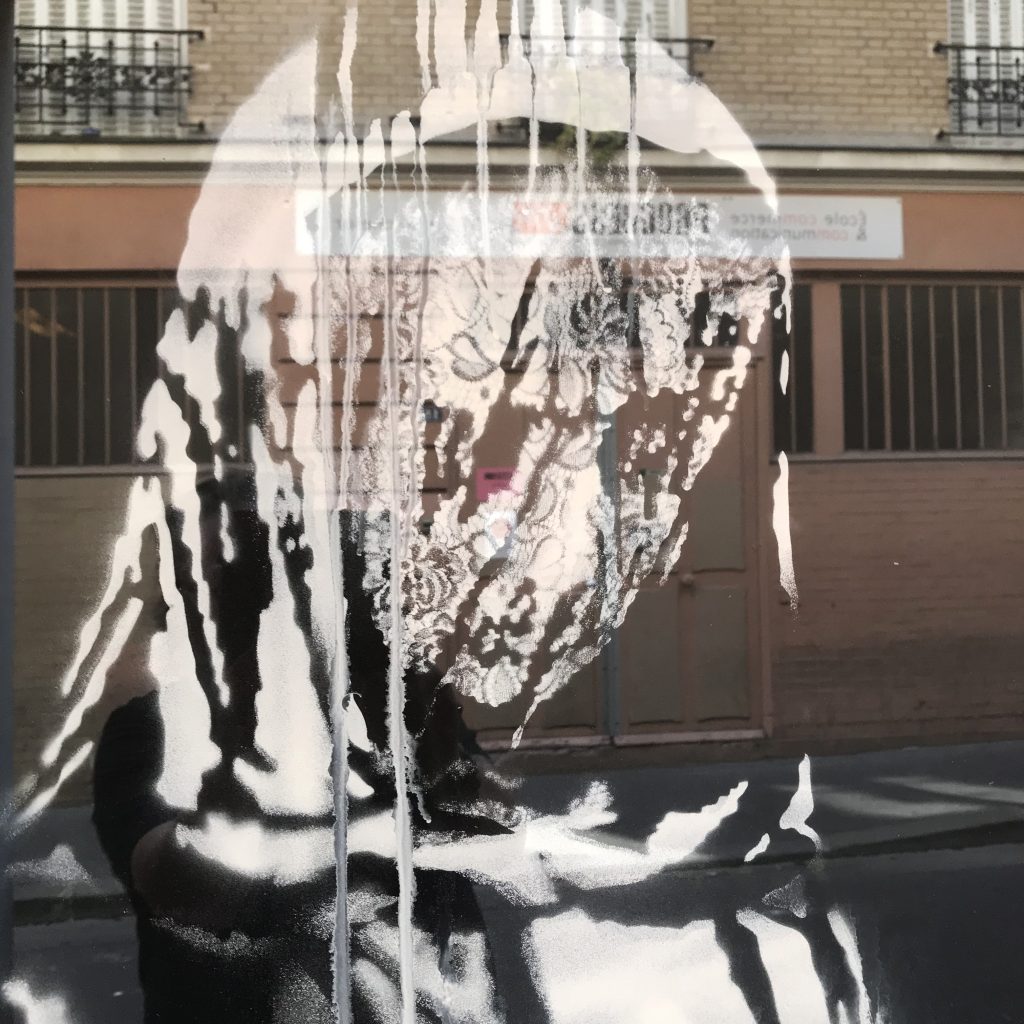
6. The Rat with a Pencil (Rue de Maistre)
This mural depicts a rat holding a pencil, donning a beret—a nod to French artistic tradition. It comments on freedom of expression and the power of art as a tool for resistance.
7. The Rat with a Bandana (Avenue de Flandre)
Located near the former refugee center “La Bulle,” this piece features a rat wearing a bandana and holding a box cutter, symbolizing defiance and the struggle for survival amidst adversity.
8. The Rat with a Bottle Cap (Rue Maitre Albert)
This artwork shows a rat standing on a bottle cap, possibly referencing the working class’s attempts to find balance and stability in a precarious environment.
8. The Rat with the Minnie Mouse Bow (Rue de Clignancourt)
Located near Rue de Clignancourt, this mural features one of Banksy’s signature rats, this time adorned with a red polka-dot bow resembling Minnie Mouse’s iconic accessory. The image juxtaposes the lighthearted charm of Disney imagery with the gritty urban environment, potentially critiquing the commodification of culture. This playful yet thought-provoking piece exemplifies Banksy’s ability to blend humor with sharp social commentary.
This mural, like others in Paris, became a focal point for fans and photographers before being defaced, underscoring the impermanent nature of street art. It remains one of Banksy’s most recognizable works from his Paris series.
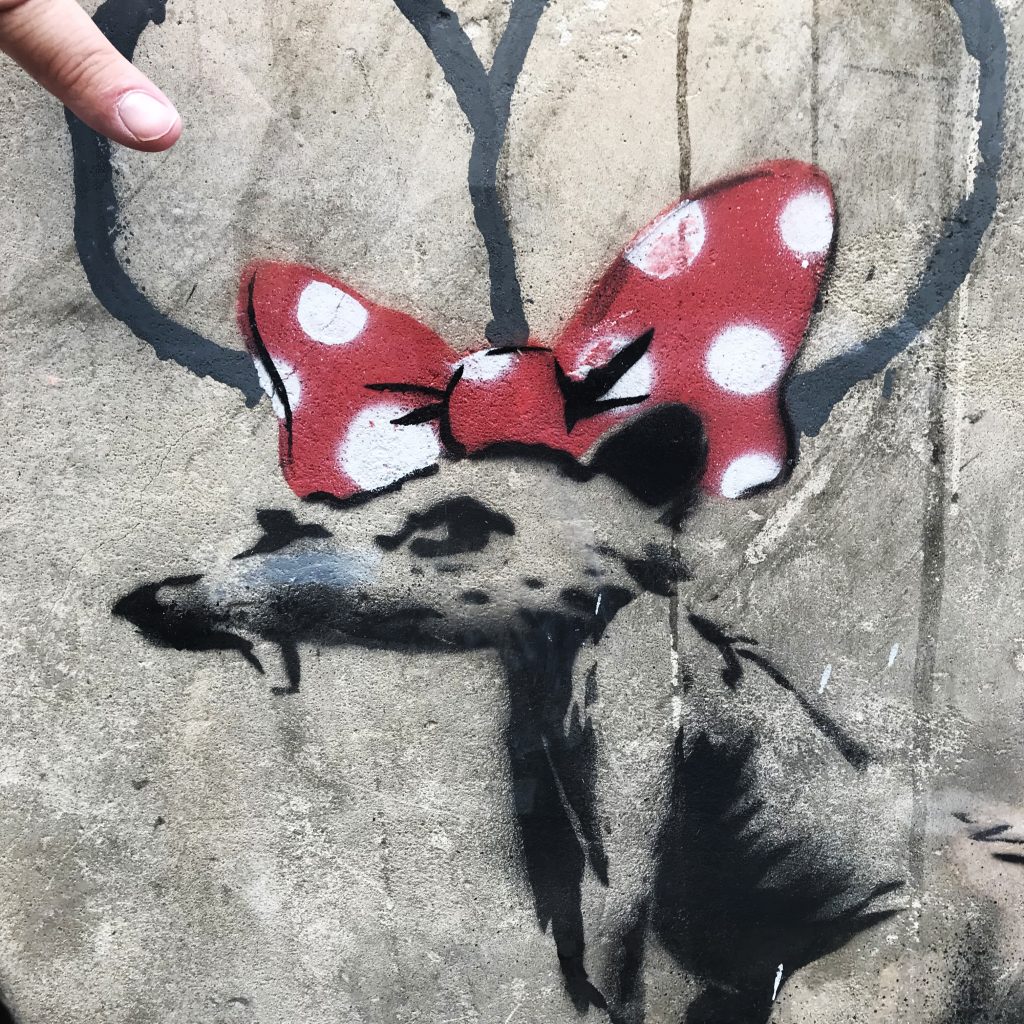
Close-up of Banksy’s Businessman with a Saw mural, focusing on the saw hidden behind the figure’s back near the Sorbonne University. Photo: Fredrik Hagblom
Contextual Analysis and Public Reception
Banksy’s Paris murals emerged during a period marked by significant socio-political discourse in France, particularly concerning immigration policies and national identity. His choice of locations—often near sites associated with historical or contemporary significance—amplified the impact of his messages. The artworks sparked diverse reactions, from admiration for their provocative themes to debates over the preservation of street art. Notably, the theft of the Bataclan mural in 2019 elicited public outcry, highlighting tensions between the ephemeral nature of street art and efforts to commodify or safeguard it.
The Value of Banksy’s Art in Today’s Market
Banksy’s works, initially created as street art meant for public consumption, have become some of the most sought-after pieces in the art market. Despite their origins as fleeting urban interventions, many of his works have been removed from their original locations and sold at auctions for extraordinary sums. For example, Love is in the Bin, a piece partially shredded during a live Sotheby’s auction in 2018, fetched £18.6 million in 2021. This incident underscored the tension between Banksy’s anti-establishment ethos and the commercial value his art has attained.
The value of his works often depends on the medium. Murals that are physically extracted from walls can sell for millions, but even smaller prints or editions command high prices. For example, prints of his famous Girl with a Balloon regularly sell for hundreds of thousands of dollars. These values are indicative of Banksy’s paradoxical position as a countercultural figure whose art is embraced by the commercial world.
In Paris, none of his murals were officially sold, as they were painted on public or private property without permission. However, some pieces, such as The Mourning Woman outside the Bataclan, have been stolen, with reports suggesting they were intended for the black market. This phenomenon raises ethical and legal questions about the commodification of street art and its removal from its original urban context.
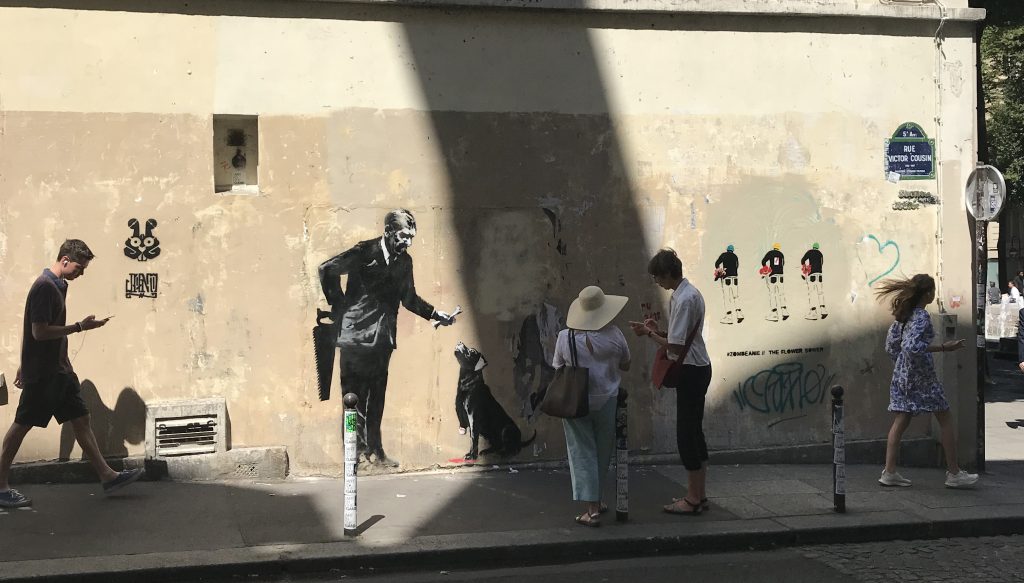
Rue victor Cousin. Photo Fredrik Hagblom
The Mystery of Banksy’s Identity
One of the enduring fascinations with Banksy lies in his anonymity. Despite being active for over two decades, the artist’s identity has never been officially confirmed, fueling rumors and speculation. Several theories have emerged, with some suggesting that Banksy is a single individual, while others argue he could be a collective of artists working under a shared pseudonym.
The most persistent rumor ties Banksy to Robert Del Naja, a founding member of the British band Massive Attack, as there have been correlations between the band’s touring schedule and the appearance of Banksy works. However, both Del Naja and Banksy have denied these claims. Another popular theory identifies Robin Gunningham, a man from Bristol, as the artist, based on investigations by journalists and researchers who used geographic profiling techniques.
Banksy’s anonymity is not only central to his mystique but also serves as a protective measure. As many of his works are technically illegal due to being painted on public or private property without permission, revealing his identity could expose him to legal action. Moreover, remaining anonymous ensures that the focus remains on his art and its messages rather than on the individual behind it.
Conclusion
Banksy’s interventions in Paris encapsulate his ability to intertwine art with socio-political commentary, utilizing the city’s urban landscape to provoke reflection and dialogue. His murals serve as a testament to the enduring power of street art in challenging societal norms and engaging the public in critical discourse. While some of his Parisian works have been lost or defaced, their legacy persists, continuing to inspire contemplation on the issues they portray.
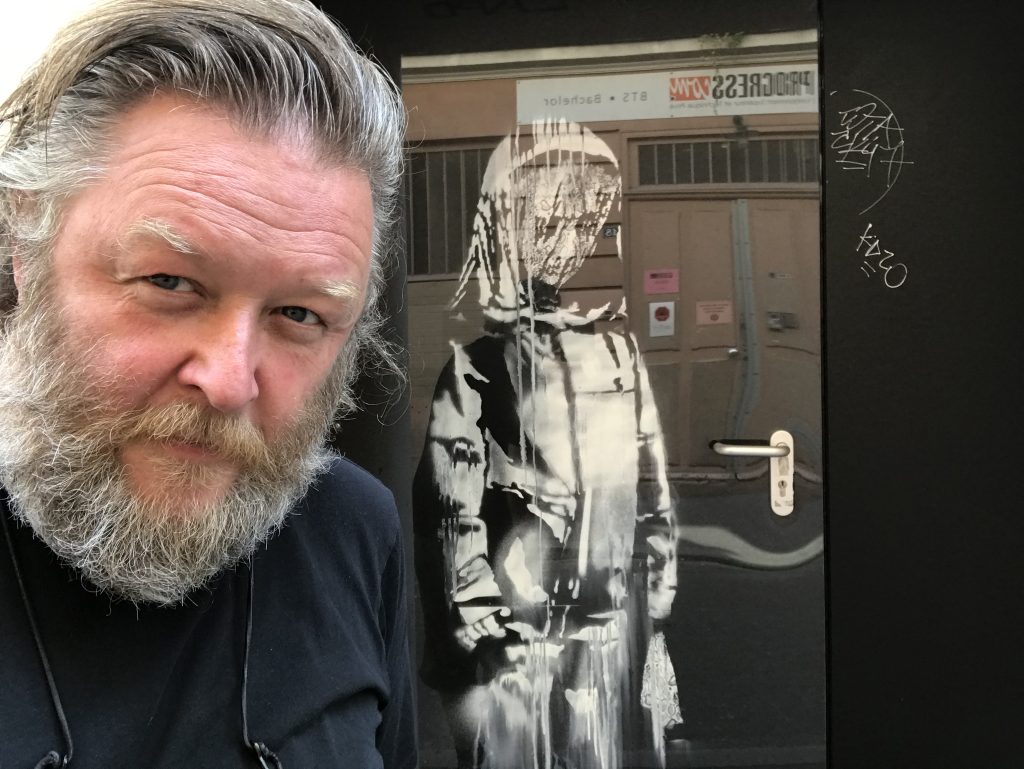
Yours truly by “The Mourning Figure” Unfortunately this image has since been stolen. Photo: Fredrik Hagblom
Check out:
Related reading
Hidden Art: Discovering Invader’s Pixel Mosaic Legacy
The AfterSquat: 59 Rue de Rivoli, Paris – A Living Canvas of Art and History
